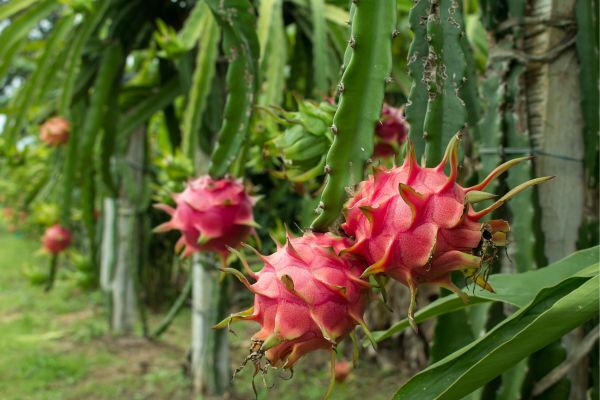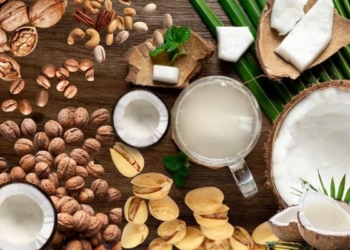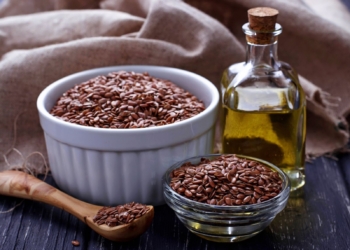Dragon fruit has become popular recently. It is liked by many for its unique look and taste. This fruit has many health benefits. We will learn how to grow dragon fruit plant and their benefits.
What is Dragon Fruit?
Dragon fruit is also known as the Honolulu queen and it is grown on the Hylocereus cactus. The flowers of this open at night only. It is native to Southern Mexico and Central America but it is grown all over the world.
Dragon fruit is known by different names like pitaya, pitahaya, and strawberry pear. The plants can give fruit for 20 years once grown. Dragon fruit flavors are similar to other fruits and it tastes like kiwi and pear.
Dragon Fruit Varieties

The dragon fruit’s common types have bright red skin with green scales like dragons.
Hylocereus Undatus (pitaya blanca) – The common variety has white pulp with black seeds.
Hylocereus Polyrhizus (pitaya roja)- The less common variety has red pulp with black seeds.
Hylocereus Guatemalensis (pitaya amarilla) – This variety is known as the yellow dragon fruit which has yellow skin and white pulp with black seeds.
How to Grow Dragon Plant from Seed
Dragon fruit is a succulent which means free-draining soil is important. Plants will rot in wet or waterlogged soils so raise the garden beds and improve soil with compost and gypsum.
Dragon fruit is like cacti it can tolerate dry periods but it gets benefits from regular watering for the good development of flowers and fruits.
Insert a stake or rose hoop so that your dragon fruit plant is trained. Tie on the stake to keep the growth vertical.
How to propagate dragon fruit
Dragon fruit can be grown from seed or cuttings easily.
To Grow from Seeds:
- Press some flesh on the paper towel and keep it moist in a warm position. But don’t keep it in direct sunlight.
- In 2-3 weeks, sprouts will come and can be put into punnets.
- Water them weekly to develop strong seedlings and keep one in each pot.
- Seedlings can take many years to grow.
To Grow from Cuttings:
- Break off a section of around 30 cm long and dry it in the shade for at least 3 to 5 days.
- This will seal the wound at the base of the cutting before planting it.
- Now, plant it in a pot and place it in part shade.
- Water is occasionally but don’t over water. Overwatering can rot the cutting.
- Once the roots are established the plant can be moved into the sun and then transplanted into the garden.
How and When to Prune Dragon Fruit
- First, establish your dragon fruit plant, then cut the main leader to start the development of a crown of growth.
- Every year remove the older stems so that it makes room for the new fruiting branches. If you don’t remove them these can become congested and can cause pests and diseases.
Ideal Growing Conditions
It is tough to grow dragon fruit everywhere as it is native to Mexico and America. So, while growing it some things should be kept in mind. You should keep in mind climate, sun exposure, soil conditions, watering, and fertilizers.
Climate
Dragon services in warm climates with high humidity as it is a tropical fruit. For its good growth, it needs a temperature between 65° to 85° F. Dragon fruit plants are very sensitive to frost and cold temperatures so these should be grown where the temperature doesn’t drop significantly even during winters. If the temperature keeps on falling in your area then plant it in a pot so that it can be kept indoors when the temperature is low.
Sunlight
Dragon fruit plant loves the sun as it is important for producing fruit. This plant can survive in direct sunlight for at least 6 to 8 hours. When they get more sunlight they grow better so they should be exposed to more sunlight. During the hottest time of the day you can provide them with shading but be careful about not providing too much shade as this can affect the growth.

Soil
The most important thing for a plant’s growth is soil and for dragon fruit, it should be well-draining. Dragon fruit is a part of the cactus family so their roots are sensitive to waterlogged conditions.
For this plant sandy or loamy soil is perfect. It prefers slightly acidic to neutral soil. Its pH should be between 6.0 to 7.0.
This kind of soil can be prepared by adding organics like compost or well-rotted manure to improve its fertility. Compost maintains good drainage and soil moisture retention.
The soil should be loose and well-aerated as it is important for root health and prevents water from pooling around the roots. These plants don’t require deep soil as they have shallow roots.
You will need a well-draining pot i.e. good drainage holes for preventing waterlogging.
Water
While planting dragon fruit, keep in mind that soil should be moist and not waterlogged. Regular watering is needed but it should be 1-2 inches per week. This will help the plant develop a robust root system in just a few months.
Once the plant is well-established it will become drought-tolerant as these plants are sensitive to overwatering.
In hot and dry climate conditions, mature dragon plants need to be watered every 1-2 weeks during the growing season.
In other climates, you can water them once every 2-4 weeks or depending on weather conditions.
Watering frequency also depends on climatic conditions or soil type. You need to water them once the top inch is dried. Provide a good soaking for encouraging deep root growth.
During the dormant season, dragon fruit plants need less water. During natural rainfall reduce watering as it can rot roots.
Fertilizer
Dragon fruit doesn’t need excessive high-nitrogen fertilizer as it promotes excessive vegetative growth at the price of fruit production. These need fertilization every 3-4 months.
Harvesting
Dragon fruit is harvested when it is fully ripened. It takes 30 days for flower formation until the fruit is ripe. This can be left on the plant for up to 10-15 days but at your own risk as birds can eat them.
To confirm that the fruit is ripened check its texture and color. While pressing it should have a slightly soft texture as it indicates that the fruit is ready for harvesting. It should also have a vibrant skin color depending on the type of variety; it can be deep pink, bright red, or yellow.
Simply twist it off the plant or cut it with pruning shears for harvesting it.
Storage Tips
Ripe fruit can be stored in the refrigerator for up to one week. Wrap the fruit in a paper towel or keep it in a perforated plastic bag as it absorbs moisture and prevents mold growth.
If you have cut the dragon fruit then the leftovers should be kept in an airtight container and kept in the refrigerator, it will last for 3 days.

If the fruit is slightly unripe then keep it in a cool and dry place, avoid keeping it in the refrigerator. It will keep on developing its color and will not get any additional flavor.
These can be cut into cubes and stored in the freezer. They will not taste as good as fresh fruit but you can use them in making delicious smoothies. These can be stored for 6 months in the freezer.
Common Problems of Dragon Fruit Plant
It is easy to grow dragon fruit plants but it may have some problems. Let us know about some of these issues:
Fruit Production
It may depend on the way of planting i.e. seeds or cutting. If there is no fruit then it may be due to not enough sunlight.
No Flowers
For getting fruit the plant must get flowers in early summer. If there are no flowers or flowers are not blooming it may be due to too cold weather or it is not getting enough sunlight. Try to keep it in direct sunlight or a greenhouse. Another reason for not getting flowers is that it is not forming productive blooms if you don’t remove dead branches. The plant is unable to provide energy to good branches due to dead weight.
Lesions on Stems and Branches
You may see spots or lesions on the stems and leaves; they can be reddish brown, yellowish, or sometimes white. Rot and canker can cause problems in plants. Remove these damaged, infected parts and give the plants good fungicides for getting rid of the problem.
Benefits of Dragon Fruit
There are numerous benefits of eating dragon fruits. Let us know about some of them:
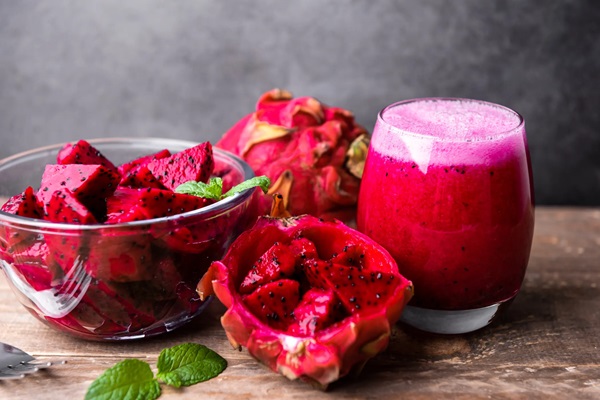
Boosts Immune System
Dragon fruit is full of vitamin C, flavonoids, and antioxidants. It also has vitamin B and minerals like calcium and phosphorus. These nutrients help develop a strong immune system as they regenerate and increase the white blood cells. The cells defend your body from bacteria and viruses.
Improves Cardiovascular Health
This fruit contains antioxidants that give your body omega-3 and omega-9 fatty acids. These acids help in improving cardiovascular health and reduce the risk of stroke and heart attack. It also reduces the cholesterol level.
Helps in Digestion
Dragon fruit is rich in dietary fiber. It acts as a prebiotic, promoting the growth of healthy bacteria that help in the digestive process.
Lowers Blood Sugar (Type 2 Diabetes)
It has fiber that helps people with type 2 diabetes. This fruit normalizes blood sugar levels and helps in losing weight. According to research, people with type 2 diabetes who don’t take insulin can decrease their blood sugar level by at least 19% when they consume dragon fruit daily.
Helps in Reducing Cancerous Cells
Red dragon fruit has lycopene (a strong antioxidant) that helps in reducing cancerous cells in the body. According to some evidence, the extract from Red Dragon helps in preventing and treating breast cancer.
Reduces Inflammation
This fruit has anti-inflammatory properties that help in reducing pain and swelling. It also helps in reducing chronic pain and inflammation from rheumatoid arthritis.
Supports Skin Health
Vitamin C and antioxidants help in treating acne and slow the progression of premature aging. These also repair cell damage and give you a youthful appearance.
Different Ways of Eating
Let us have a look at some of the dragon fruit recipes:
- Fruit Snack or Salad: It can be added to the fruit salad.
- Refreshing Drinks: Make your dragon fruit drink with fresh chunks or frozen fruit. It is perfect for all the cravings.
- Smoothies: They can be added to your smoothie for some nutrition.
- Ice Creams or Sorbets: You can add them to ice cream or sorbet as it gives amazing color and flavor.
- Popsicles: Beat the heat of summer with some dragon fruit popsicles. These are loved by everyone, especially children.
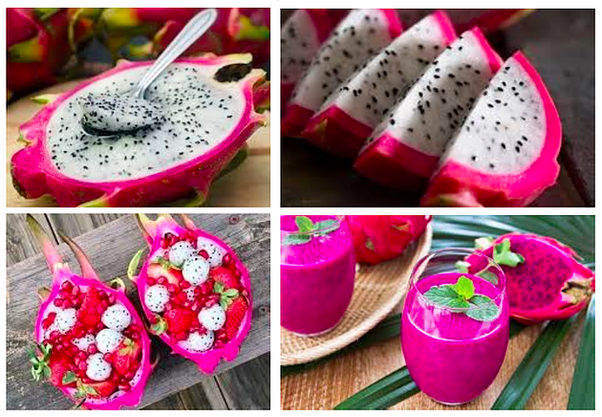
You can also serve them with pancakes, waffles, and french toast. These can be used for garnishing cakes, pudding, ice creams, and more.
Allergy Symptoms and Side Effects
Dragon fruit is safe for most people but some may have allergic reactions. These symptoms may include swelling of the tongue, hives, vomiting and stomach cramps, shortness of breath, wheezing, repetitive cough, shock or circulatory collapse, trouble swallowing or tight throat, weak pulse, dizziness, or feeling faint and pale or blue skin color.
Usually, it is safe to eat dragon fruit but its overconsumption can cause some problems:
- Due to overconsumption, it can cause cell damage.
- Gastrointestinal problems can arise due to consuming more dietary fiber.
- More risk of gestational diabetes and low blood pressure.
- Weight gain when consumed in place in greater quantity.
Also read: What exactly is Soymamicoco – Made for a Plate
Final Note
Dragon fruit plant has different varieties with different health benefits. In the article, we have talked about growing plants, storage tips, benefits, and allergy symptoms.
We hope that it will help you with all the information about dragon fruit plants.
